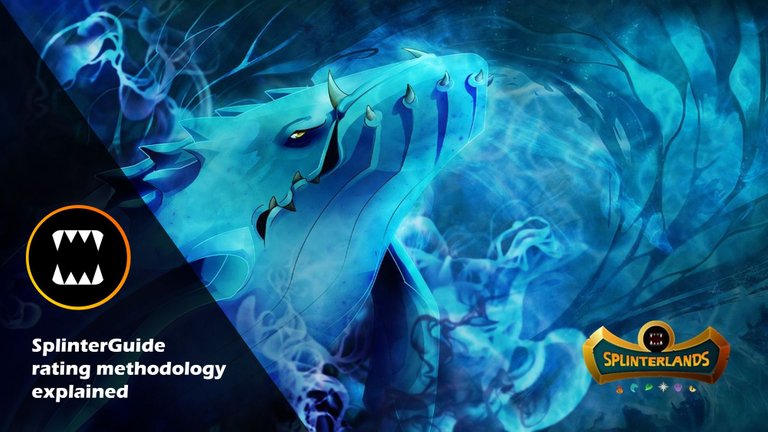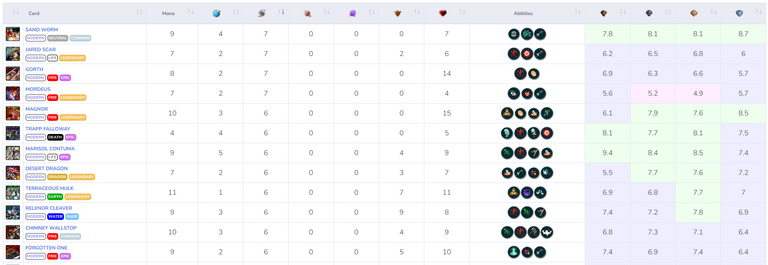
When we first shared SplinterGuide, the bulk of the questions we got were around the rating methodology, so I wanted to address this in detail to share how we came up with all the card ratings on the site. This is specifically for Monsters.
When starting SplinterGuide, one of the primary goals was to provide card ratings so players could, at-a-glance, find the best cards for their collections. We initially debated between entirely manual vs. automated ratings for cards, and ultimately settled an a solution that is mostly programmatic but also involves some human intervention. This enables us to score every card in a more consistent way while also applying a human factor needed when the system can't quite capture all the elements.
Note that the methodology and specific numbers below are subject to change as our ratings are still in a “Beta” phase.
Each card is scored based on the following inputs, at each league (thus taking into account the stats and abilities available at the appropriate league):
Stats:
Each basic stat (Mana, Melee, Ranged, Magic, Speed, Armor, and Health) has its own increment value and, in certain cases, a modifier (bonus or penalty).
For example, the score for the Armor stat is 0.125 x [Armor] and there is are 2 modifiers (+0.1 for [Armor]>0 and -0.25 for [Armor]==0).
Multiple attach types and no attack types:
Cards with multiple attack types (e.g. Kralus) are given a 0.5 point bonus.
Cards with no attack types (e.g. Pelacor Conjurer) are given a 0.5 point penalty.
Abilities:
For abilities, we went through and ranked every ability for every ruleset to generate two ratings: a “standard ruleset ability rating” and a “non-standard ruleset ability rating” (from 0.1 to 1). The “standard” score is given a 20% weight and the “non-standard” score an 80% weight to factor in the frequency of “non-standard” rulesets. Although this weighting isn’t an exact reflection of the frequency of the “standard” ruleset showing up, we landed on this because there are many cases where abilities are unaffected by a certain ruleset.
While the scores themselves are still evolving, here are some examples of the range:
- Deathblow is a 0.1
- Forcefield is a 0.5
- Heal is a 1
In addition, certain types of skills are given multipliers to reflect their current usefulness in the game meta (e.g. Healing abilities given a 1.25x multiplier and Martyr a 1.6x multiplier)
The scores are then given to cards who have the respective abilities.
Ability synergies:
There are many abilities that synergize with one another, such as Thorns and Amplify for example. Furthermore, there are some strong synergies and some weak synergies. We maintain a table of synergistic abilities and rate each on a scale of 1-3 (1 == Low synergy, 3 == High synergy).
Cards that have multiple synergistic abilities are granted bonuses based on whether it’s a Low, Medium, or High synergy.
Here are 3 examples:
- High ability synergy: Amplify + Thorns
- Medium ability synergy: Taunt + Enrage
- Low ability synergy: Retaliate + Trample
Note that “Low” synergy doesn’t mean “No” synergy! There is still a bonus for a “Low” synergy, but it’s lower than for “Medium” or “High” synergies.
We currently have 84 synergies in our table.
Stat + Ability synergies:
In addition to ability synergies, we also recognize certain abilities that synergize with stats. For example Demoralize synergizes well with a Melee monster, Silence with a Magic monster, and Headwinds with a Ranged monster. These synergies give cards a further bonus.
Card type:
We give Neutral cards a 0.5 point bonus for their flexibility.
Meta adjustments (fudge):
To account for card and splinter synergies, as well as the ongoing meta, we apply “fudge” factors on top of the above scoring. These are manually added and help finetune the programmatic ratings to better reflect real in-game value. We currently have ~60 of these adjustments, and the scoring range mostly goes from -2 to +2, therefore it doesn’t massively interfere with the programmatic rating. An example here is Failed Summoner, which is an great card in its own right but an AWESOME card when you take into account synergies with cards in its own splinter like Mylor and Queen Mycelia, and also a terrific counter to Magic which is often played in the Earth splinter. The “fudge” bonus factors those components in. In the future we may add more programmatic solutions to take into account elements like card synergies.
League multiplier:
The value of a stat or ability in Bronze league is different than its value in Champion. For example, 3 melee may be commonplace at the highest leagues but awesome in lower leagues. Similarly, “heal” is awesome in all leagues but even more valuable in lower leagues where it’s less commonplace. To account for this we apply league multipliers when computing league-specific ratings. The league multipliers are set separately for each stat and for abilities. This is because certain things change less in terms of value across leagues (such as mana).
I've made this information available on the site directly, and will keep it updated as changes are made to the methodology.
If there's interest, I can of course share more details on the individual scores as well.
What do you think? Are there key components you think are missing to our scoring methodology? Anything you feel we could do to improve? We would love to hear your feedback!









